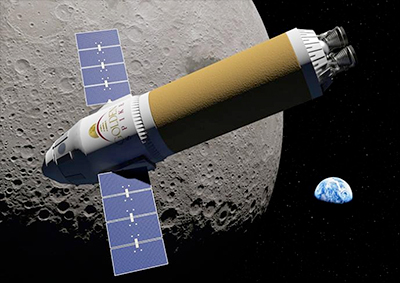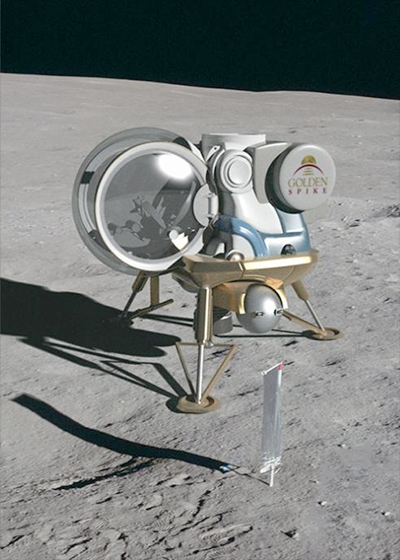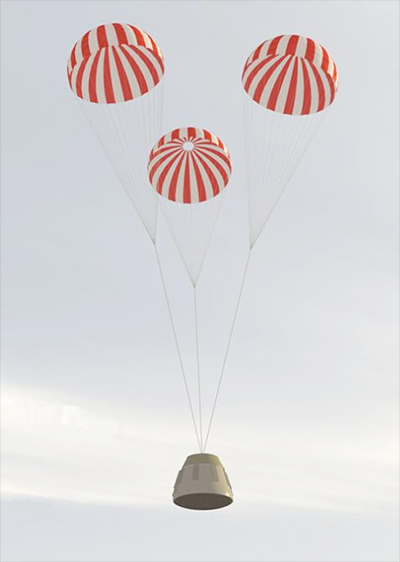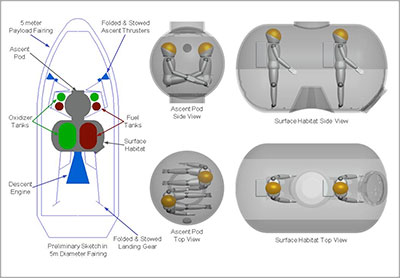|
|

|
 |
| Forum: | Commercial Space - Military Space |
| Topic: | Golden Spike commercial human lunar exploration |
|
| Want to register?
|
If you have previously registered, but forgotten your password, click here.
At the National Press Club announcement this afternoon, Dr. Stern, Golden Spike's President and CEO, and Mr. Griffin, chairman of Golden Spike's board of directors, introduced other members of Golden Spike's leadership team and detailed the company's intentions to make complete lunar surface expeditions available by the end of the decade. "A key element that makes our business achievable and compelling is Golden Spike's team of nationally and internationally known experts in human and robotic spaceflight, planetary and lunar science, exploration, venture capital formation, and public outreach," said Dr. Stern. The company's plan is to maximize use of existing rockets and to market the resulting system to nations, individuals, and corporations with lunar exploration objectives and ambitions. This approach, capitalizing on available rockets and emerging commercial-crew spacecraft, dramatically lowers costs to create a market for human lunar exploration. Golden Spike estimates the cost for a two-person lunar surface mission will start at $1.4 billion. This price point enables human lunar expeditions at similar cost as what some national space programs are already spending on robotic science at the Moon.  Dr. Stern and Mr. Griffin described Golden Spike's "head start" architecture that has been two years in the making and vetted by teams of experts, including former space shuttle commander Jeffrey Ashby, former Space Shuttle Program Manager Wayne Hale, and Peter Banks, a member of the National Academy of Engineering. It has also been accepted for publication in the American Institute of Aeronautics and Astronautics' (AIAA) Journal of Spacecraft and Rockets, a leading aerospace technical journal. The paper will be available on Golden Spike's web site, which will debut shortly. As announced today by CEO Stern, Golden Spike has initiated a series of studies with small and large aerospace companies to begin designs for the lunar lander, lunar space suits, and lunar surface experiment packages to be used on Golden Spike missions. The company also announced that it will sponsor an international conference for the scientific community in 2013 on the science that can be done on Golden Spike lunar expeditions. Golden Spike expects its customers will want to explore the Moon for varying reasons — scientific exploration and discovery, national prestige, commercial development, marketing, entertainment, and even personal achievement. Market studies by the company show the possibility of 15-20 expeditions in the decade following a first landing.  "We could not be able to do this without the many breakthroughs NASA made in inventing Apollo, the Shuttle, the International Space Station, and its recent efforts to foster commercial spaceflight," said Golden Spike Board chairman Gerry Griffin. "Building on those achievements, The Golden Spike Company is ready to enable a global wave of explorers to the lunar frontier." "We're not just about America going back to the Moon; we're about American industry and American entrepreneurial spirit leading the rest of the world to an exciting era of human lunar exploration," said Dr. Stern, "It's the 21st century, we're here to help countries, companies, and individuals extend their reach in space, and we think we'll see an enthusiastic customer manifest developing." Homer Hickam, author of Rocket Boys (the inspiration for the blockbuster space movie October Sky) and a member of Golden Spike's extensive advisory board, remarked on the company's public launch saying: "A reliable pathway to the Moon — 'Earth's eighth continent' will open our nearest neighbor in space to extensive new exploration, and also open it to the imagination of people everywhere."  See here for discussion of the Golden Spike Co.'s commercial moon missions. | | Robert Pearlman | Golden Spike Company release Board of Directors - Gerry Griffin
Board Chair
Apollo Flight Director, former Director of Johnson Spaceflight Center, former head of Greater Houston Chamber of Commerce - Alan Stern
President and CEO
Planetary scientist, former head of all NASA science missions,
and "Time Magazine 100" honoree - Cindy Conrad
Treasurer
Businesswoman and commercial space expert, formerly at NASA headquarters Planetary Science Division - Esther Dyson
Director
NewSpace investor and venture capitalist - James R. French
Director
Propulsion and space systems expert - Doug Griffith
Director and Board Secretary
Aerospace attorney, former Marine Corps aviator; safety/risk management expert - David Lackner
Director
Spacecraft systems engineer, former venture capitalist - Michel Loucks
Director
Expert in orbital mechanics and mission design - Taber MacCallum
Director
Life support system expert and space executive - Max Vozoff
Director
Business development expert and former program manager of SpaceX's Dragon spacecraft development
Board of Advisors - Conrad Anker
Renowned mountaineer, outdoorsman and author ("The Lost Explorer") - Bobby Block
Award-winning journalist, author and communications expert - Michael Bostick
CEO of Walden Media - Andrew Chaikin
Acclaimed space historian and author - Jonathan Clark, M.D.
Former NASA Space Shuttle flight surgeon - Nancy Conrad
Education innovator,
founder of The Conrad Foundation,
widow of Apollo 12 moonwalker Pete Conrad - Newt Gingrich
Former U.S. Speaker of the House of Representatives, U.S. presidential candidate, and commercial space advocate - Wayne Hale
Former chief of NASA's Space Shuttle program - Homer Hickam
Former NASA engineer,
acclaimed author and screen writer ("Rocket Boys"/"October Sky") - Chris Kemp
Former NASA Chief Information Officer, Silicon Valley internet entrepreneur - Stephen Mackwell
Director, Lunar and Planetary Institute; renowned planetary scientist - Tod Mesirow
Motion picture producer,
co-founder of Five by Five Productions - Mike Okuda
Hollywood graphic and set designer ("Star Trek") - Bill Richardson
Former U.N. Ambassador, former U.S. Secretary of Energy, former Governor of New Mexico, former U.S. presidential candidate, and commercial space advocate - Bob Walker
Former U.S. congressman, chairman of the U.S. House Science Committee, and commercial space advocate - Zak Williams
Director of Marketing, Moon Express
Lunar Lander Systems (LLS) Teams - Armadillo Aerospace
- International Lunar Observatory Association
- Masten Space Systems
- Moon Express
- Paragon Space Development Corp.
- Southwest Research Institute
- Space Florida
- United Launch Alliance
- Zero Point Frontiers Corp.
| | Robert Pearlman | Golden Spike Company release The Golden Spike Company Announces Northrop Grumman Under Study Contract for Lunar Lander DesignThe Golden Spike Company announced today that it has entered into a contract with Northrop Grumman Corporation for the design of a new lunar lander that fits within Golden Spike's "head start" commercial lunar architecture. Northrop Grumman's participation brings heritage lunar engineering expertise to Golden Spike. Northrop Grumman is a major aerospace and defense contractor. Its legacy companies -- Grumman and TRW -- designed and built the Lunar Module and Lunar Module Descent Engines for the Apollo moon landing missions that between 1969 and 1972 ferried a crew of two astronauts from lunar orbit to the lunar surface and back again six times. Golden Spike debuted last month as the first commercial aerospace company planning to offer routine exploration expeditions to the surface of the Moon by the end of the decade. The company aims to use existing rockets and emerging commercial-crew spacecraft to allow nations, individuals and corporations to mount their own lunar expeditions. The lander is the only significant hardware that needs to be designed from the ground up. "This is a significant step forward in our plans," said Golden Spike's Board Chairman, Gerry Griffin. "Northrop Grumman brings Golden Spike a unique body of knowledge and skills as the only company to ever build a successful human-rated lunar lander, the Apollo Lunar Module." Dr. S. Alan Stern, Golden Spike's President and CEO, added: "We're very proud to be working with Northrop Grumman, which has the most experience and successful performance record for human lunar lander designs in the world." Among the tasks Northrop Grumman will perform for Golden Spike are: - Reviewing requirements and synthesizing a set of study ground rules and assumptions emphasizing system reliability, automated/ground command operability, and affordability
- Establishing velocity (δv) budgets from and to low lunar orbit for pragmatic lunar landing sites
- Exploring a wide variety of Lunar Lander concept options, including staging, propellants, engines, reusability, autonomy, systems capabilities for exploration, as well as landing site flexibility
- Establishing the design trade space and establish pragmatic limits for future more detailed analysis and development
"This study is one of a number of initial studies we're undertaking to begin creating the design requirements and specs for the lander contract competition we expect to hold to select a Golden Spike lander for flight development," said Golden Spike's Lunar Lander Systems Study (LLaSS) engineering chief, James R. French. Golden Spike predicts its customers will want to explore the Moon for varying reasons — scientific exploration and discovery, national prestige, commercial development, marketing, entertainment, and even personal achievement. Market studies by the company show the possibility of 15-25 or more expeditions in the decade following a first landing. | | Robert Pearlman | Golden Spike Company release The Golden Spike Company Launches Lunar Exploration Crowdfunding CampaignGolden Spike — a private company led by former NASA executives offering human expeditions to the Moon for nations, corporations, and individuals — today kicked off a 10-week Indiegogo crowdfunding campaign to raise $240,000 — representing each mile on the way to the Moon. The drive aims to raise awareness about Golden Spike, accelerate Golden Spike's plans for innovative public participation in its activities, and give the global community of space enthusiasts and the general public a chance to help fuel Golden Spike's human Lunar exploration mission. "In the weeks after we unveiled the company last December, we were inundated with emails and letters and tweets from thousands of people asking how they can help. We think this Indiegogo campaign is an absolutely awesome way to get the public more involved in helping grow our mission," said Golden Spike President and CEO Dr. Alan Stern. "Golden Spike is building a program that is all about connecting people to Lunar exploration," he added. "We hope that this campaign and all the projects it enables will generate a degree of participation in space exploration that has never existed before" said Gerry Griffin, former Apollo Flight Director and the Chairman of Golden Spike's Board of Directors. Indiegogo campaign contributions to Golden Spike will allow Golden Spike to create interactive media products, apps, and an Olympics Movement-style membership program for children and adults to take part in Golden Spike activities as insiders. They will also help fund Golden Spike's Lunar expedition studies and other activities. "We want to make it possible for people to follow Golden Spike's development and space missions just like people follow Hollywood, NASCAR, and professional sports," said Dr. Stern. Golden Spike's campaign is being launched through Indiegogo.com (www.Indiegogo.com). The public can get involved at different levels with a range of perks and incentives offered at each level. People can connect to the campaign on Golden Spike's website (www.goldenspikecompany.com) as well as through its Facebook, Twitter and LinkedIn pages. The Golden Spike Company is a private business planning a series of expeditions to explore the Moon by nations, corporations, and individuals from around the globe, beginning in 2020. Led by former NASA leaders, Golden Spike includes experienced space-industry veterans, world-renowned planetary scientists, and senior space engineers. The company estimates each two-person Lunar expedition to cost $1.5 billion — a breakthrough making human expeditions possible for the cost of present-day robotic missions on the Moon. To view Golden Spike's Indiegogo campaign, click here. | | Robert Pearlman | Northrop Grumman release Northrop Grumman Completes Lunar Lander Study for Golden Spike CompanyNorthrop Grumman Corporation (NYSE:NOC) has completed a feasibility study for a new commercial lunar lander for the Golden Spike Company (GSC). The study confirmed the viability of lander concepts for Golden Spike's human lunar expedition architecture and conceived a novel new, low-mass ascent stage concept dubbed "Pumpkin."  Above: This figure shows a preliminary sketch of the minimalist ascent pod with surface habitat concept packaged in a five-meter diameter payload fairing. The pressurized compartments and propellant tanks easily fit in the available space. Ascent thrusters are mounted on outriggers that are folded up to fit in the payload fairing and the landing gear is folded inward. Also shown are initial side and top views of the ascent pod "Pumpkin" and the surface habitat with crew members in pressure suits. (Credit: Northrop Grumman) Northrop Grumman's study for Golden Spike conducted the following tasks: - Reviewed GSC's level one requirements and synthesized a set of study ground rules and assumptions emphasizing automated operations, simplicity and low cost.
- Established propulsion requirements for lunar orbit loiter, descent to the lunar surface, ascent to low lunar orbit and rendezvous with a crew vehicle for pragmatic lunar landing sites.
- Developed current and stretch factors to reflect the improvement in relevant technologies since the completion of the Apollo program.
- Evaluated 180 lunar lander cases for various options and sensitivities including loiter, staging, propellants, engines, surface duration, surface cargo and technology basis.
- Established a pragmatic design trade space for future more detailed analysis and development.
The study determined that for GSC's mission architecture, there are many more options for all cryogenic propellants compared with storable propellants, but that multiple storable propellant options are possible. Cryogenic propellants have higher performance, but are more difficult to contain for the GSC mission duration than storable propellants such as those used in the Apollo program. A novel set of options using a minimalist pressurized ascent pod and descent stage with a surface habitat was also studied and shown to be viable. Layout sketches of this concept show that it can be packaged within a five-meter diameter fairing payload envelope. Three-dimensional solid models with representative crew members established target pressurized volumes for the ascent pod and surface habitat. This unique approach has a good chance of meeting GSC's objectives with all-storable propellants, which reduces development risks and costs. Martin McLaughlin, Northrop Grumman's study lead, said, "This concept has significant operability advantages for surface exploration since the surface habitat can be segmented to isolate lunar dust and provides more space for living and for selecting the most valuable lunar return samples. We affectionately call the minimalist ascent pod 'Pumpkin' because of its spherical shape and because it returns the crew to orbit after the surface exploration party." Alan Stern, president and chief executive officer, GSC, said, "Northrop Grumman has done an exemplary job and helped advance Golden Spike's technical approach to renewed human lunar exploration. The study's results are very exciting and will help enable a new wave of human lunar exploration that Golden Spike plans." Northrop Grumman and its legacy companies – Grumman Aerospace and TRW -- designed and built the Apollo Lunar Module and Lunar Module Descent Engines. | | Robert Pearlman | Golden Spike Company release Golden Spike Welcomes Jim Lovell to First Commercial Lunar Expedition CompanyLegendary Astronaut Joins GSC Board of Advisors Golden Spike, the first company planning to undertake human lunar expeditions for countries and corporations around the world, announced today (May 15) that legendary astronaut and Apollo 13 Commander Jim Lovell has joined its Board of Advisors. Capt. Lovell, a former Naval aviator and test pilot, is a recipient of the Congressional Space Medal of Honor and the Presidential Medal of Freedom. Lovell is one of only 24 people to have flown to the Moon, was the first of only three people to fly to the Moon twice, and was the first person to fly in space four times. Since leaving the space program, Lovell has had a distinguished career in the private sector, including serving as President and CEO of Bay-Houston Towing Company and President of Fisk Telephone Systems. Today, he is president of Lovell Communications, a business devoted to disseminating information about the U.S. Space Program. Lovell's experience as both space explorer and successful businessman makes him a vital addition to Golden Spike's already prestigious advisory team, which includes distinguished space industry veterans, entertainment industry captains, former high ranking NASA officials, experienced Washington politicians, and venture capitalists. "Jim's background in human space flight operations and his success in the private sector is an awesome combination for Golden Spike," said Gerry Griffin, a former Apollo Flight Director and the Chairman of Golden Spike's Board of Directors. "Having his unique perspective and advice available to the Golden Spike team will be invaluable." "Finally there's a company, Golden Spike, that plans a purely commercial approach to returning to the moon," said Capt. Lovell. "I am pleased to be part of this enthusiastic group of engineers and scientists working together with the aerospace industry to design and build cost effective lunar flights." A complete list of Golden Spike's Advisory Board can be found here. | | Robert Pearlman | Golden Spike Company release Golden Spike Partners with Honeybee Robotics to Design Lunar RoversEffort Will Enhance Scientific Return of Commercial Human Expeditions to the Moon The Golden Spike Company — the world's first enterprise planning to undertake human lunar expeditions for countries, corporations and individuals — announced today a partnership with Honeybee Robotics — a premier provider of robotic systems for space — to design unmanned rovers capable of enhancing the next human missions to the Moon. Working with technical staff at Golden Spike, Honeybee engineers will conduct trade studies for the design of configurable robotic rovers that can collect and store scientific samples from the Moon's surface in support of Golden Spike's expeditions. The results of the study will be complete by mid-2014. Honeybee has extensive expertise in planetary sampling and geotechnical analysis, having delivered systems for the last three of NASA's Mars landers, including the Rock Abrasion Tool for the Mars Exploration Rovers; the "Phoenix Scoop" for the Phoenix Mars Lander; and the Dust Removal Tool and Sample Manipulation System for the Mars Science Laboratory. The company's facilities are equipped with NASA-certified clean rooms and unique space environment simulation chambers. "We're very proud to be working with Honeybee, which has tremendous experience and a record of successful performance in the development of flight systems for NASA," said Dr. S. Alan Stern, Golden Spike's President and CEO. "For over 25 years, Honeybee has been delivering innovative robotics for space and planetary exploration," said Steve Gorevan, co-founder and Chairman of Honeybee Robotics. "Our team has experience developing dozens of planetary sampling, sample processing, instrumentation and mobility technologies for missions to Mars, the Moon and asteroids. It is an honor to be working with Golden Spike and helping them advance human spaceflight through lunar exploration." Earlier this year, an international scientific workshop led by Golden Spike proposed new concepts for lunar missions, including robotic-human expeditions. The proposal envisions sending robotic systems to the Moon to collect samples ahead of a crewed Golden Spike expedition to retrieve the robot's cache. The concept allows the scientific return of a mission to be more extensive, since it would include samples collected by the rover many miles (kilometers) away from a landing site. Golden Spike's lunar science advisory board chair, Dr. Clive Neal, of Notre Dame University, applauded the partnership with Honeybee, saying it would enhance the scientific potential of Golden Spike's human missions. "Honeybee brings a unique body of knowledge and skills to help us augment the capabilities of human exploration missions with advanced robotics," Dr. Neal said. "Their participation is a key step forward in helping Golden Spike change the paradigm of human space exploration, through the development of highly capable lunar exploration system architecture for customers around the world." The study with Honeybee is one of a number that Golden Spike is undertaking with industry partners in preparation for future flight system procurements. Market studies already conducted for the company show the possibility of 15-25 or more expeditions in the decade following a first landing. | | Robert Pearlman | Golden Spike Company release Golden Spike Partners with Draper Laboratory to Conduct Lunar Landing Site StudyEfforts to maximize the extent of the Moon that Golden Spike missions can explore The Golden Spike Company — the world's first enterprise planning to undertake human lunar expeditions for countries, corporations and individuals — announced today a partnership with Draper Laboratory to examine the range of landing sites that Golden Spike can offer for its commercial human missions to the Moon. Draper provides advanced Guidance, Navigation and Control (GN&C) systems, high-performance, reliable space science instruments, and processing systems for NASA and the U.S. military. Draper provided similar landing site selection studies to NASA's Constellation lunar landing program. The study with Draper is one of a number that Golden Spike is undertaking with industry partners in preparation for future flight system procurements. Market studies already conducted for the company show the possibility of 15 to 25 expeditions in the decade following a first commercial landing. Working with technical staff at Golden Spike, Draper engineers will: - Evaluate the compatibility of the Golden Spike lander concepts to determine how the constraints of safely landing, lighting, terrain, orbit, delta-V capability, etc. affect the fraction of the lunar front side available as potential landing areas
- Evaluate potential enhancements to the Golden Spike landers that may further increase the potential area available for landing
- Define a recommended notional architecture for Golden Spike lunar mission guidance system including functional allocation, algorithms functionality and electronic architecture
The results of the work will be complete by mid-2014. "We're proud to be working with Draper, the gold standard for lunar mission landing site selection, dating from Apollo to the present," said Dr. S. Alan Stern, Golden Spike's President and CEO. "Draper has provided the GNC and flight computers, for all crewed lunar landings. We are excited to bring this expertise to assist Golden Spike in its ambitious objective of opening the lunar frontier," said Draper study lead John West. | |





